Multidisciplinarity, Citizen Participation and Geographic Information System, Cross-Cutting Strategies for Sustainable Development in Rural Heritage. The Case Study of Valverde de Burguillos (Spain)
Abstract
1. Introduction
2. Theoretical Framework
3. Case Study: Valverde de Burguillos
4. Methodology
- MAPPING RESOURCES. Identification of human, cultural, and natural resources. The consideration of the patrimonial element beyond the object to identify patrimonial values of a different nature (landscape, economic, social, environmental…). The vision provided by the local administration, from the academy and from citizen participation is considered of the utmost importance. To achieve this, it has been necessary to determine which sources of information the different stakeholders provide and to trace these thoroughly (Table 2).
- REACHING A CONSENSUS on what to protect. To develop this phase, a collaborative mapping strategy is used, which implies working in tandem with all the stakeholders involved.
- INTEGRATION OF INFORMATION INTO THE URBAN DEVELOPMENT FRAMEWORK. Drawing up of a heritage map of the heritage resources of the municipality based on the information provided by the different stakeholders. Said document has been made available to the Administration.
- Creation of a georeferenced database for alphanumeric and graphic information input. Given the heterogeneous nature not only in the data format, but also in its subject matter, the interdisciplinary meetings between researchers, technicians, citizens, and the administration to gather data and contrast information are noteworthy. Furthermore, numerous field visits have been carried out in Valverde de Burguillos, including stays of varying duration. A preliminary task has been undertaken prior to devising the information fields consisting of the definition of a series of attributes (columns of the data tables) in accordance with the subsequent analysis to be performed.
- Management of spatial and thematic information. Integration, consultation, and interpretation of the data on a digital cartographic base built for Valverde de Burguillos aimed at generating valid conclusions for the study.
- Analytical functions. Handling of information on a Geographic Information System (GIS) basis, data crossing, and generation of new information and points of view on the layers that comprise the project. Amongst these graphic analysis functions we find: vectorisation of the agricultural territorial information from the SIGPAC viewer (surfaces of ecological interest, landscape elements, cartography, places of regional interest (LIC)). Coupled with the foregoing is the analysis of visual basins using the Digital Surface Model at 5m from the 2018 LIDAR flight; the comparative analysis of disperse edifications using topographical maps from 1945 to 2019. Lastly, the digitisation of citizen created maps, overlapped with vectorial layers from cartographic severs.
- Representation and output of information. Characterisation of the ethnographic heritage, symbolisation and justified identification of the heritage elements. In this stage, care has been taken to ensure that the notification of information has been synthetic and clear. For this reason, the maps had to contain a simple symbology and express few yet potent ideas (for example, the map of significant heritage elements for the citizens, though those not contemplated by the administration). It became evident to create tables broken down into elements with a more user-friendly graphic format than the internal GIS tables. Therein, the information fields must be combined (which include positive and negative appraisals of each element, aside from the basic information) with illustrative images to assist comprehension.
5. Findings
5.1. Phase 1: Mapping of Natural, Cultural, and Human Resources
5.1.1. Assets Protected from within the Public Sector Administration
5.1.2. The Contribution of Academic and Research Works
5.1.3. Citizens’ Perception
- The first activity was developed individually in which each of the participants was provided with a card, where from the five senses they had to reflect those identity elements of Valverde, the causes, and suggestions to improve it. The proposal was made to tackle the phrase: “We would take from Valverde… because…”
- Activity 2 consisted of the same card, but where they had to identify those anomalous elements. We focused on the phrase: “It is not possible that … it will continue to occur in the next 100 years because...”
- Activity 3, conducted in 3 groups of 12 people, consisted of identifying, among all, those elements of their area with a special value, and for this they were provided with planimetry and colours to locate them on the plans, both on a territorial and urban level. They were proposed to work with the phrase: “… it is an element (that should be) valued as historical heritage because… Its state of conservation is… because…”.
5.2. Phase 2: Reaching a Consensus. The Role of Cartographies
- Overlap with the cattle routes: streams, roads, trails, resting places, and royal herding tracks. There is no doubt that there is a close relationship between the elements, both those that are catalogued and those that are not, of “La Cultura del Agua” with the cattle trails that cross the urban centre of Valverde de Burguillos and make up the rural routes of the municipality. Almost all of the constructions are located on livestock pathways, except for “El Charco” and “El Pilar”, which are located in the urban nucleus, which indicates that they are historical paths for ranchers and travellers to their lands or nearby municipalities (Figure 7). The livestock pathways are the following: “Colada del Camino del Ventoso” (where the “Fuente Nueva” is located); “Colada del Camino de Atalaya” (connects the urban nucleus of the municipality with the “Cañada Real de Burguillos”); “Cañada Real de Burguillos” (royal herding track) (links Valverde de Burguillos with Zafra, Burguillos del Cerro, and Jerez de los Caballeros and in it is the Najarrillo mill running to form the northeast border of the municipality of Valverde); rest of the Bodión River (borders and accompanies the Bodión River as it passes through the municipality of Valverde de Burguillos, linking the “San Luis” electrically powered flourmill, “La Presa” and the “Mayo” mill); “Colada de la Carretera” that connects the “Colada del Camino de Jerez” (the Jerez Laundry Path) with the Río Bodión at the level of “El Pocito” and reaches the “Colada del Camino de Atalaya” (Atalaya Laundry Path) at a point near the hermitage; the “Colada del Camino de Jerez” (the Jerez Laundry Path) (to the west of the urban centre, concentrates the largest number of elements included in “La Cultura del Agua” dossier).
- Hydrography and “La Cultura del Agua”:While the relationship may be straightforward, it is of the utmost importance to analyse how these elements relate to it. If it seems plausible to partially justify the location of the different sources, cisterns, laundries, and other elements through the reading of the livestock pathways, the hydrographic reading of the territory responds to this question to a greater degree. A whole series of land elements underpins these fountains and pools, most of which, as in the case of “La Reina” and “El Pocito”, are composed, in addition to water storage, of a system of ditches that distributes water to nearby orchards. In the case of sources located in the urban nucleus (“El Pilar” and “El Charco”), it is relevant that they rise in the vicinity of the source of a stream. Nowadays, these represent the urban boundary of Valverde de Burguillos and it is likely that this is due to the initial location of these elements, directly linked to the hydrography of the territory.
- Urban progression and “La Cultura del Agua”:Since all the elements, except “Fuente Nueva” (1920), date from before 1900 and that the cadastral information dates the constructions from 1900, it is difficult to analyse urban evolution together with the progression of “La Cultura del Agua.” However, the set of territorial elements that have been seen so far have considerably conditioned the location and development of the urban nucleus.
5.3. Phase 3—Integration of Information in the Urban Development Framework
6. Discussion
7. Conclusions
Author Contributions
Funding
Acknowledgments
Conflicts of Interest
References
- Pereira Roders, A.; Bandarin, F. (Eds.) Reshaping Urban Conservation. The Historic Urban Landscape Approach in Action; Springer Nature Singapore: Singapore, 2019. [Google Scholar] [CrossRef]
- United Nations Human Settlements Programme (UN-Habitat). Urban Planning for City Leaders; United Nations Human Settlements Programme (UN-Habitat): Nairobi, Kenya, 2012; Available online: https://unhabitat.org/sites/default/files/download-manager-files/UNHabitatUPCL14-02624-Combine.pdf (accessed on 9 October 2020).
- Sánchez-Mesa Martínez, L.J. Planning territorial policies against inner areas depopulation in Spain: Keys for sustainable management of cultural and environmental resources. Il Cap. Cult. 2019, 19, 53–81. [Google Scholar] [CrossRef]
- Gallar Hernández, D.; Acosta Naranjo, R. La resignificación campesinista de la ruralidad: La Universidad Rural Paulo Freire. Rev. Dialectol. Tradic. Pop. 2014, 69, 285–304. (In Spanish) [Google Scholar] [CrossRef]
- Cardoso, R.T.; Arango, M.A. Conocimiento local y culturas tradicionales como base para el desarrollo sostenible: El caso del uso y manejo de las dehesas de encina en el suroccidente peninsular. Etnicex: Rev. Estud. Etnográficos 2014, 6, 21–43. (In Spanish) [Google Scholar]
- United Nations. Transforming Our World: The 2030 Agenda for Sustainable Development (A/RES/70/1); United Nations: New York, NY, USA, 2015; Available online: Ttps://www.un.org/en/development/desa/population/migration/generalassembly/docs/globalcompact/A_RES_70_1_E.pdf (accessed on 13 December 2019).
- UNESCO. Hangzhou Outcomes. International Conference ‘Culture for Sustainable Cities’; UNESCO: Hangzhou, China, 2015; Available online: http://www.unesco.org/new/fileadmin/MULTIMEDIA/HQ/CLT/pdf/SustCit_Hangzhou_Outcomes_EN.pdf (accessed on 10 October 2020).
- United Nations. Implementation of the Outcomes of the United Nations Conferences on Human Settlements and on Housing and Sustainable Urban Development and Strengthening of the United Nations Human Settlements Programme (UN-Habitat); United Nations: New York, NY, USA, 2016; Available online: http://habitat3.org/wp-content/uploads/N1639668-English.pdf (accessed on 15 December 2019).
- HABITAT III. Habitat III. Zero draft of the New Urban Agenda; Habitat III: Quito, Ecuador, 2016; Available online: https://www.worldurbancampaign.org/sites/default/files/Habitat%20III%20Zero%20Draft%20outcome%20document%20(May%202016)_0.pdf (accessed on 15 May 2019).
- Council of Europe. Cultural Heritage in the 21st Century for Living Better Together. Towards a Common Strategy for Europe. Namur Declaration; Belgian Chairmanship CoE: Namur, Belgium, 2015; Available online: https://delegacionacreenecco.files.wordpress.com/2015/06/namur-declaration-en-final.pdf (accessed on 15 October 2020).
- Pereira Roders, A.; Van Oers, R. Editorial: Bridging cultural heritage and sustainable development. J. Cult. Herit. Manag. Sustain. Dev. 2011, 1, 5–14. [Google Scholar] [CrossRef]
- UNESCO. Culture Urban Future. Global Report on Culture for Sustainable Urban Development; Unesco: Paris, France, 2016; Available online: http://unesdoc.unesco.org/images/0024/002459/245999e.pdf (accessed on 20 April 2020).
- Torres, J.C.; López, L.; Romo, C.; Soler, F. An Information System to Analize Cultural Heritage Information. In Progress in Cultural Heritage Preservation. EuroMed 2012. Lecture Notes in Computer Science; Ioannides, M., Fritsch, D., Leissner, J., Davies, R., Remondino, F., Caffo, R., Eds.; Springer: Berlin/Heidelberg, Germany, 2012; Volume 7616, pp. 809–816. [Google Scholar] [CrossRef]
- Pinto Puerto, F.S. La tutela sostenible del patrimonio cultural a través de modelos digitales BIM y SIG como contribución al conocimiento e innovación social. PH Boletín Inst. Andaluz Patrim. Histórico 2009, 93, 27–29. (In Spanish) [Google Scholar] [CrossRef]
- Domínguez-Ruiz, V.; Rey-Pérez, J.; Rivero-Lamela, G. Contribution to the Knowledge of Cultural Heritage via a Heritage Information System (HIS). The Case of ‘La Cultura del Agua’ in Valverde de Burguillos, Badajoz (Spain). Sustainability 2020, 12, 1141. [Google Scholar] [CrossRef]
- Silva Pérez, R.; Fernández Salinas, V. El nuevo paradigma del patrimonio y su consideración con los paisajes: Conceptos, métodos y prospectivas. Doc. d’Anàlisi Geogràfica 2017, 63, 129–151. (In Spanish) [Google Scholar] [CrossRef]
- Gullino, P.; Loris Beccaro, G.; Larcher, F. Assessing and Monitoring the Sustainability in Rural World Heritage Sites. Sustainability 2015, 7, 14186–14210. [Google Scholar] [CrossRef]
- Tillería, J. La arquitectura sin arquitectos, algunas reflexiones sobre arquitectura vernácula. AUS [Arquitectura/Urbanismo/Sustentabilidad] 2017, 8, 12–15. (In Spanish) [Google Scholar] [CrossRef]
- Rudofsky, B. Architecture Without Architects: A Short Introduction to Non-Pedigreed Architecture; Museum of Modern Art: New York, NY, USA, 1964. [Google Scholar]
- Carrión Gútiez, A. Planes Nacionales de Patrimonio Cultural; Secretaría General Técnica, Subdirección General de Documentación y Publicaciones, Ministerio de Educación, Cultura y Deporte: Madrid, Spain, 2015. Available online: https://sede.educacion.gob.es/publiventa/descarga.action?f_codigo_agc=15101C (accessed on 12 July 2020). (In Spanish)
- Maldonado Ramos, L.; Vela Cossío, F. Arquitectura popular en el Valle del Tiétar. Narria Estud. Artes Costumbres Pop. 1996, 75, 1–7. Available online: https://repositorio.uam.es/bitstream/handle/10486/8520/45804_1.pdf?sequence=1 (accessed on 25 June 2020). (In Spanish).
- Carrera, G. La arquitectura vernácula de la Andalucía rural. Un análisis comparado de dos inventarios. ARA. Tierra Sur. Patrim. Cult. Desarro. Rural Andalucía 2004, 15, 24–29. Available online: http://www.revistatierrasur.com/revistas/articulos/24-29TS15arquitecturavernacula.pdf (accessed on 15 September 2020). (In Spanish).
- ICOMOS. Charter on the Built Vernacular Heritage (1999); ICOMOS: Roma Norte, Mexico, 1999; Available online: https://www.icomos.org/images/DOCUMENTS/Charters/vernacular_e.pdf (accessed on 30 August 2020).
- Woods, M. Performing rurality and practising rural geography. Prog. Hum. Geogr. 2010, 34, 835–846. [Google Scholar] [CrossRef]
- OECD. Edinburgh Policy Statement on Enhancing Rural Innovation. In Proceedings of the 11th OECD Rural Development Conference, Edinburgh, UK, 9–12 April 2018; Available online: https://www.oecd.org/regional/11th-rural-development-conference.htm (accessed on 10 October 2020).
- OECD. Delivering Rural Well-Being. In Proceedings of the 12th OECD Rural Development Conference, Seoul, Korea, 24–26 September 2019; Available online: https://www.oecd.org/rural/rural-development-conference/ (accessed on 10 October 2020).
- Matero, F. Ethics and policy in conservation. Conser. Perspect. GCI Newsl. 2000, 15, 1. Available online: https://www.getty.edu/conservation/publications_resources/newsletters/15_1/feature1_2.html (accessed on 10 September 2020).
- Roders, A.P. How can urbanization be sustainable? A reflection on the role of city resources in global sustainable development. BDC. Boll. Del Cent. Calza Bini 2013, 13, 79–90. [Google Scholar] [CrossRef]
- O’Connor, J. Panel discussion on the contribution of creativity to sustainable development. In Proceedings of the UNESCO Hangzhou International Congress, Culture: Key to Sustainable Development, Hangzhou, China, 15–17 May 2013. [Google Scholar]
- Gómez, J.I.L. Dos experiencias de recuperación integral del patrimonio arquitectónico: La Catedral de Santa María de Vitoria y el Valle Salado de Salinas de Añana. Berceo 2006, 151, 133–143. (In Spanish) [Google Scholar]
- UNESCO. Preliminary Report on the Draft Recommendation on the Historic Urban Landscape; UNESCO: París, France, 2010; Available online: https://unesdoc.unesco.org/ark:/48223/pf0000189099. (accessed on 12 October 2020).
- Portugués, I.M. Mértola Vila Museu. Modelo rural de difusión del Patrimonio Cultural. In Cuadernos de Investigación Urbanística (Ci[ur]), 1st ed.; Instituto Juan de Herrera, Ed.; Universidad Politecnica de Madrid—University Library: Madrid, Spain, 2018; Volume 117, pp. 1–80, (In Spanish). [Google Scholar] [CrossRef]
- Evans, G. Measure for measure: Evaluating the evidence of culture’s contribution to regeneration. Urban Stud. 2005, 42, 959–983. [Google Scholar] [CrossRef]
- Nijkamp, P.; Riganti, P. Assessing cultural heritage benefits for urban sustainable development. Int. J. Serv. Technol. Manag. 2008, 10, 29–38. [Google Scholar] [CrossRef]
- Verdini, G.; Frassoldati, F.; Nolf, C. Reframing China’s heritage conservation discourse. Learning by testing civic engagement tools in a historic rural village. Int. J. Herit. Stud. 2017, 23, 317–334. [Google Scholar] [CrossRef]
- Rey-Pérez, J.; Siguencia Ávila, M.E. Historic urban landscape: An approach for sustainable management in Cuenca (Ecuador). J. Cult. Herit. Manag. Sustain. Dev. 2017, 7, 308–327. [Google Scholar] [CrossRef]
- Buckley, K.; Cooke, S.; Fayad, S. Using the Historic Urban Landscape to re-imagine Ballarat. The local context. In Urban Heritage, Development and Sustainability. International Frameworks, National and Local Governance; Labadi, S., Logan, W., Eds.; Routledge, Taylor and Francis Group: London, UK; New York, NY, USA, 2016; pp. 93–113. [Google Scholar]
- Tweed, C.; Sutherland, M. Built cultural heritage and sustainable urban development. Landsc. Urban Plan. 2007, 83, 62–69. [Google Scholar] [CrossRef]
- Scheffler, N.; Kulikauskas, P.; Barreiro, F. Managing urban identities: Aim or tool of urban regeneration? Urbact Trib. 2009, 9–13. Available online: https://www.academia.edu/5882659/Managing_Urban_Identities_01 (accessed on 17 November 2020).
- Chías, P.; Abad, T. GIS tools for comparing historical and contemporary landscapes through local map series. e-Perimetron 2009, 4, 61–72. [Google Scholar]
- Sharma, R.S.; Samuel, E.M.; Ng, E.W. Beyond the digital divide: Policy analysis for knowledge societies. J. Knowl. Manag. 2009, 13, 373–386. [Google Scholar] [CrossRef]
- Statuto, D.; Cillis, G.; Picuno, P. GIS-based Analysis of Temporal Evolution of Rural Landscape: A Case Study in Southern Italy. Nat. Resour. Res. 2019, 28, 61–75. [Google Scholar] [CrossRef]
- INE—Instituto Nacional de Estadística. Available online: https://www.ine.es/ (accessed on 1 January 2019).
- Fundación BBVA. La población de Badajoz; Fundación BBVA: Madrid, Spain, 2007. (In Spanish) [Google Scholar]
- Acosta-Naranjo, R.; Domínguez Jara, J.A.; Domínguez-Ruiz, V. Activa Valverde, un caso de vinculación de la sociedad civil y la Universidad contra la despoblación. Rev. PH Inst. Andaluz Patrim. Histórico 2019, 98, 210–221. (In Spanish) [Google Scholar] [CrossRef]
- Gallardo, J.A. Apuntes Para la Historia de Valverde de Burguillos; Diputación de Badajoz: Badajoz, Spain, 2014. [Google Scholar]
- Herrera Rodríguez, K.G. Edaphoclimatic Potential of Valverde de Burguillos for Ecological Agriculture and the Acclimatisation of Some Crops Typically Found in the Latin American Diet. Master’s Thesis, Universidad Internacional de Andalucía, Seville, Spain, 24 September 2019. [Google Scholar]
- Centro de Descargas. Sistema de Información Territorial de Extremadura SITEX. Available online: http://sitex.gobex.es/SITEX/centrodescargas (accessed on 2 August 2020). (In Spanish).
- Carnicero Valero, I. “La Cultura del Agua” in the Territorial Enclave of Valverde de Burguillos. Characterization of the Ethnographic Heritage through Geographic Information Systems. Bachelor’s Thesis, Universidad de Sevilla, Sevilla, Spain, 2018. Available online: https://personal.us.es/racosta/Articulos/12.TFG-L_ICV-entregado.pdf (accessed on 25 January 2020).
- Consejería de Cultura e Igualdad de la Junta de Extremadura. Resolución de 22 de Marzo de 2019, de la Consejería de Cultura e Igualdad, por la que se Incoa Nuevo Expediente, para la Declaración de Bien de Interés Cultural a Favor de ‘La Cultura del Agua’ en Valverde de Burguillos (Badajoz). Boletín Oficial del Estado, Núm. 150 de 24 de Junio de 2019. Referencia BOE-A-2019-9510. 2019, pp. 67207–67222. Available online: https://www.boe.es/diario_boe/txt.php?id=BOE-A-2019-9510 (accessed on 14 October 2020). (In Spanish).
- España, Ley 2/1999, de 29 de marzo, de Patrimonio Histórico y Cultural de Extremadura. Boletín Oficial del Estado, núm. 139, de 11 de junio de 1999. Referencia BOE-A-1999-13022. 1999. Available online: https://www.boe.es/buscar/pdf/1999/BOE-A-1999-13022-consolidado.pdf (accessed on 2 March 2019). (In Spanish).
- UNESCO. Recommendation on the Historic Urban Landscape, Including a Glossary of Definitions. 2011. Available online: http://portal.unesco.org/en/ev.php-URL_ID=48857&URL_DO=DO_TOPIC&URL_SECTION=201.html (accessed on 23 April 2019).
- Río Bodión Community. Office of Urban Management, Housing, Architecture and Territory. Municipal Masterplan Valverde de Burguillos “Documento de Avance Memoria Informativa”. Available online: http://extremambiente.juntaex.es/files/Memoria%20Informativa%20PGM%20Valverde%20de%20Burguillos.pdf (accessed on 2 May 2020).
- Consejería de Medio Ambiente y Rural, Políticas Agrarias y Territorio. Available online: http://extremambiente.juntaex.es/index.php?option=com_content&view=article&id=1026&Itemid=171 (accessed on 10 May 2018). (In Spanish).
- Sistema Geográfico Nacional de Parcelas Agrícolas SIGPAC. Available online: http://sigpac.mapama.gob.es/fega/visor; https://www1.sedecatastro.gob.es/ (accessed on 23 April 2018). (In Spanish).
- Sistema de Información Geográfico Agrario SIGA. Available online: https://www.mapa.gob.es/es/agricultura/temas/sistema-de-informacion-geografica-de-datos-agrarios/ (accessed on 13 December 2019). (In Spanish).
- Castellanos Mendoza, M. Vernacular Housing Architecture in Valverde de Burguillos (Badajoz). Contribution to the Knowledge of Its Heritage Values. Bachelor’s Thesis, Universidad de Sevilla, Sevilla, Spain, 2018. Available online: https://personal.us.es/racosta/Articulos/11.Prueba.NOTFG_Mo%CC%81nica Castellanos Mendoza.pdf (accessed on 15 September 2020).
- WMS Ortofoto PNOA del Instituto Geográfico Nacional. Available online: http://www.juntadeandalucia.es/medioambiente/site/rediam/menuitem.04dc44281e5d53cf8ca78ca731525ea0/?vgnextoid=2d0c5997c8de5410VgnVCM2000000624e50aRCRD&vgnextchannel=867122ad8470f210VgnVCM1000001325e50aRCRD&vgnextfmt=rediam&lr=lang_en (accessed on 30 June 2019). (In Spanish).
- Centro de Información Cartográfica y Territorial de Extremadura (CICTEX). Available online: http://sitex.gobex.es/SITEX/centrodescargas/viewsubcategoria/43 (accessed on 30 June 2019). (In Spanish).
- Pérez Morillo, J.M. Diagnosis of productive alternatives linked to organic farming and processing of its products into Valverde de Burguillos (Badajoz). Master’s Thesis, Universidad Pablo de Olavide, Sevilla, Spain, 2018. Available online: https://personal.us.es/racosta/Articulos/14.%20TFM%20JOSE%20MAR%C3%8DA%20P%C3%89REZ%20MORILLO-2-134.pdf (accessed on 25 January 2020).
- Martínez Barrena, J.A. Ecological Use of Wild Plants in Valverde de Burguillos (Badajoz). Master’s Thesis, Universidad Pablo de Olavide and Universidad Internacional de Andalucía, 2019. Available online: https://personal.us.es/racosta/Articulos/5.%20TFM%20_JA_MZ_Barrena.pdf (accessed on 25 January 2020).
- Bermúdez Vázquez, V. Asparagus Harvesting in the Face of Depopulation in Valverde de Burguillos (Badajoz). Master’s Thesis, Universidad de Sevilla,, Seville, Spain, 2018. Available online: https://personal.us.es/racosta/Articulos/3.%20TFM_ESPA%CC%81RRAGOS%20VIRGINIA%20BERMUDEZ%20VAZQUEZ.pdf (accessed on 25 January 2020).
- Blasco Martín, E. Current Situation and Potential for Agro-Ecological Development of the Bodión River and its Surrounding Ecosystems for Valverde de Burguillos (Badajoz). Master’s Thesis, Universidad Internacional de Andalucía,, Sevilla, Spain, 2017. Available online: https://personal.us.es/racosta/Articulos/15.%20NO.%20TFM_VAlverde_ElenaBlasco.pdf (accessed on 25 January 2020).
- Guillén Camisón, P. Approach to Digital Knowledge for the Dissemination of Architectural Heritage as A Measure to Combat Depopulation. Case Study: Valverde de Burguillos (Badajoz). Master’s Thesis, Universidad de Sevilla, Seville, Spain, 2019. Available online: https://personal.us.es/racosta/Articulos/Patricia%20Guillen_Plataforma_final.pdf (accessed on 30 June 2019).
- Rodríguez Maguillo, J. A Collaborative Platform to Enhance the Vernacular Heritage in Rural Settings. Bachelor’s Thesis, Universidad de Sevilla, Sevilla, Spain, 2018. Available online: https://personal.us.es/racosta/Articulos/13.Memoria TFG-Javier.pdf (accessed on 5 July 2020).
- Sesma Álvarez, T. Application of New Technological Advances to Built Rural Heritage. Analysis of the Current State and Proposal for the Use of the Najarrillo Mill, Valverde de Burguillos, Badajoz. Master’s Thesis, Universidad de Sevilla, Sevilla, Spain, 2017. [Google Scholar]
- Carrascosa Goméz, I. Constructive Characterisation of Vernacular Buildings of a Vernacular Nature in Valverde de Burguillos: Cataloguing, Analysis, Recommendations for Maintenance and Repairs in Raw Earth Walls and Masonry. Bachelor’s Thesis, Universidad de Sevilla, Sevilla, Spain, 2018. Available online: https://idus.us.es/handle/11441/79494 (accessed on 2 October 2020).
- Arévalo Ortíz, C. Identification and Recovery of the Food Heritage Related to the Sensory Landscape of the Inhabitants of Valverde de Burguillos and Analysis of the Potential of the Enhancement of a Product Related to the Territory. Master’s Thesis, Universidad de Sevilla,, Seville, Spain, 2018. Available online: https://personal.us.es/racosta/Articulos/2.TFM_CECILIA_culturaalimentaria.pdf (accessed on 10 August 2020).
- Zúñiga Sepúlveda, D. The Audiovisual Register as an Instrument for the Integration and Socialisation of Cultural Heritage in Valverde de Burguillos. Master’s Thesis, Universidad de Sevilla, Seville, Spain, 2018. Available online: https://personal.us.es/racosta/Articulos/4.%20TFM_DANIELA.pdf (accessed on 30 August 2019).
- I Taller de Iniciativas Vernáculas. Patrimonio y Sostenibilidad Para Una Nueva Ruralidad; Domínguez-Ruiz, V., Rivero-Lamela, G., Eds.; III Plan Propio de Docencia de la Universidad de Sevilla: Sevilla, Spain, 2018. (In Spanish) [Google Scholar]
- Rey-Pérez, J.; Domínguez-Ruiz, V. II Taller de Iniciativas Vernáculas en Valverde de Burguillos. Crónica del Bodión 2019, 1, 18. (In Spanish) [Google Scholar]
- Calderón Torres, C.M. Arquitectura vernácula de Extremadura I: Diseño de un inventario. Oficina de Patrimonio Etnológico. Dirección General de Patrimonio Cultural. Junta de Extremadura. Consejería de Cultura y Turismo: Madrid, Spain, 2011. Available online: https://www.scribd.com/document/451742425/ARQUITECTURA-VERNACULA-DE-EXTREMADURA-I-Diseno-de-un-Inventario-OFICINA-DE-PATRIMONIO-ETNOLOGICO-1-pdf (accessed on 2 September 2020). (In Spanish).
- Díaz García, E. El Inventario de arquitectura vernácula en Extremadura supera los 6000 registros. Rev. PH 2009, 72, 8–9. (In Spanish) [Google Scholar] [CrossRef]
- Rey-Pérez, J.; Tenze, A. The citizen participation in the Management of Urban Heritage of the city of Cuenca (Ecuador). Estoa, Rev. la Fac. Arquit. y Urban. la Univ. Cuenca 2018, 7, 129–141. [Google Scholar] [CrossRef]
- Medeiros, E.; van der Zwet, A. Sustainable and Integrated urban Planning and Governance in Metropolitan and Medium-Sized Cities. Sustainability 2020, 12, 5976. [Google Scholar] [CrossRef]
- STOA. Strategies for Enhancing the Rural Heritage of Valverde de Burguillos as a Driving Force for Rural Development. A STOA Project for the Town Council of Valverde de Burguillos; Rural Development Programme of Extremadura 2014–2020; STOA: Badajoz, Spain, 2020. [Google Scholar]
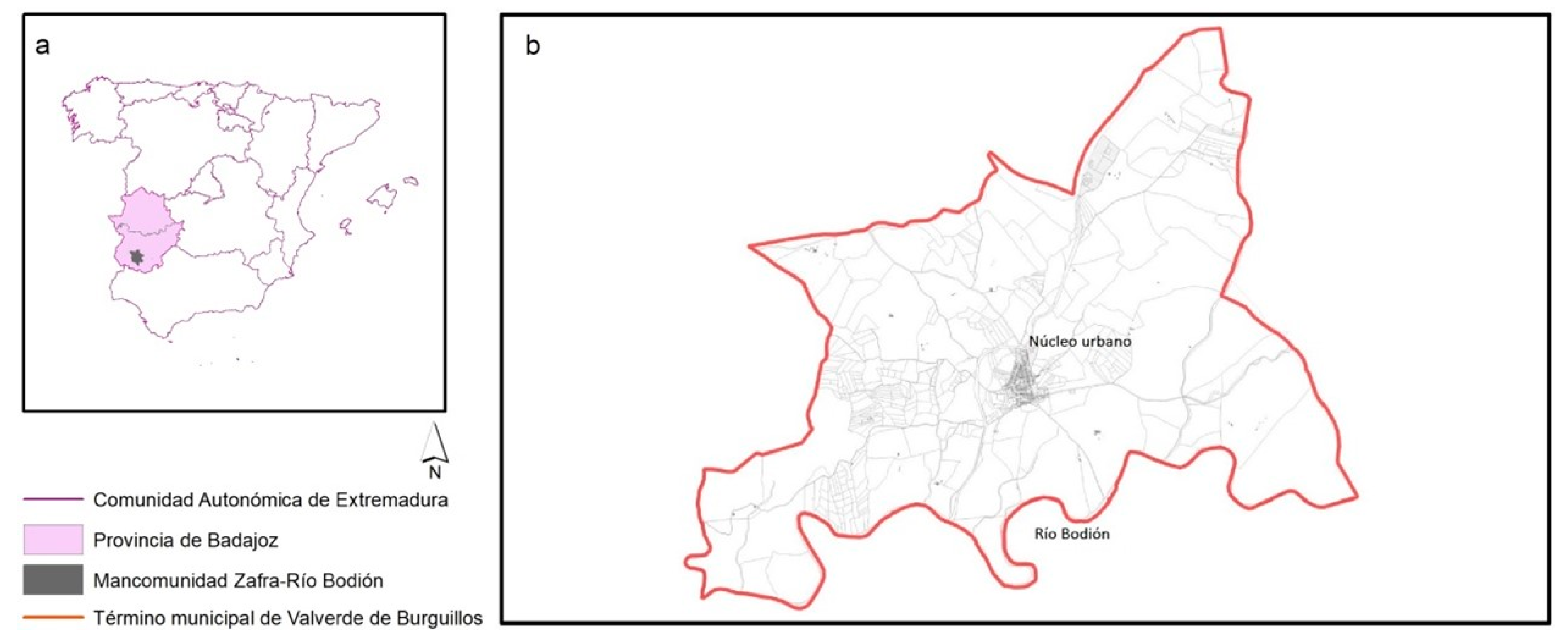
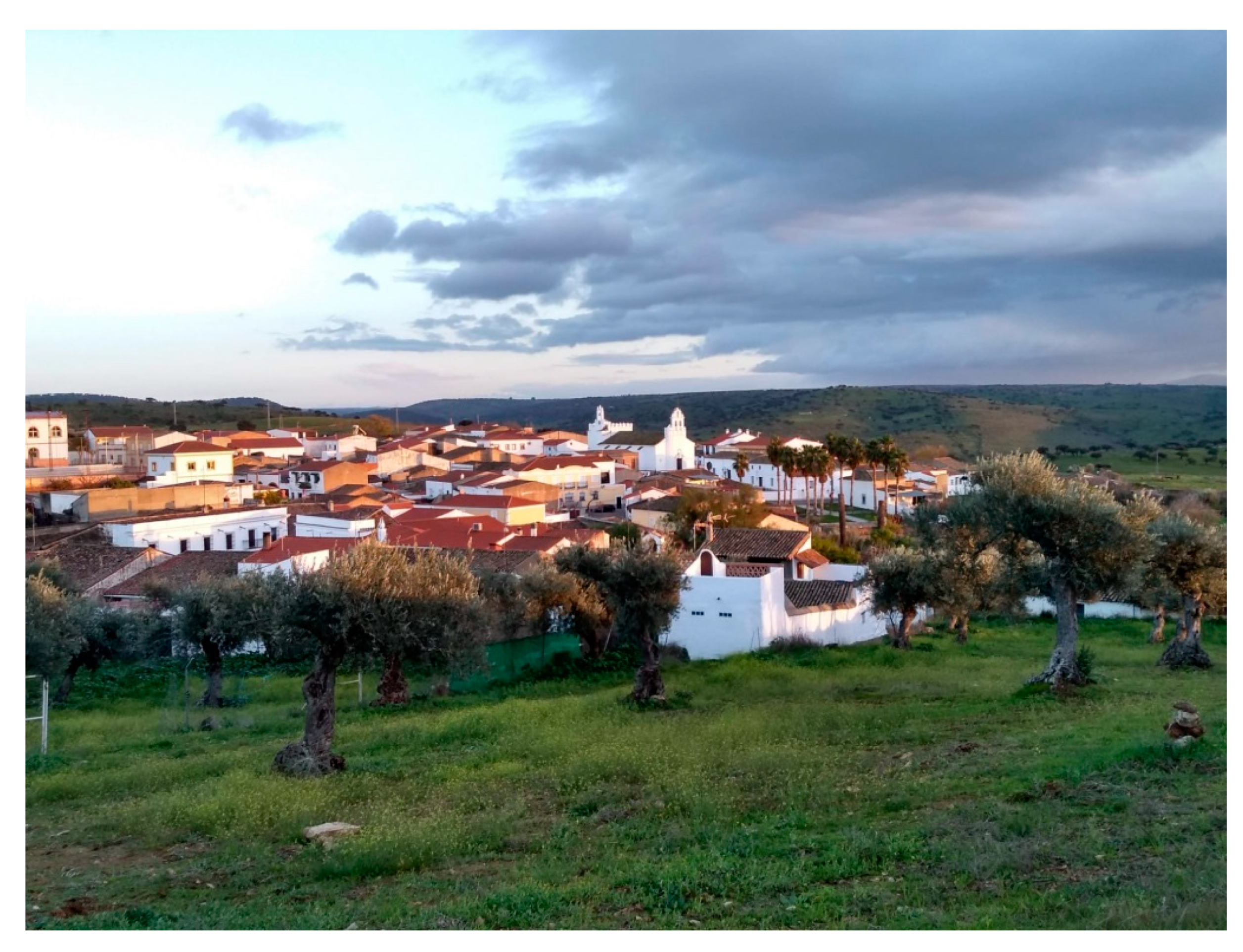
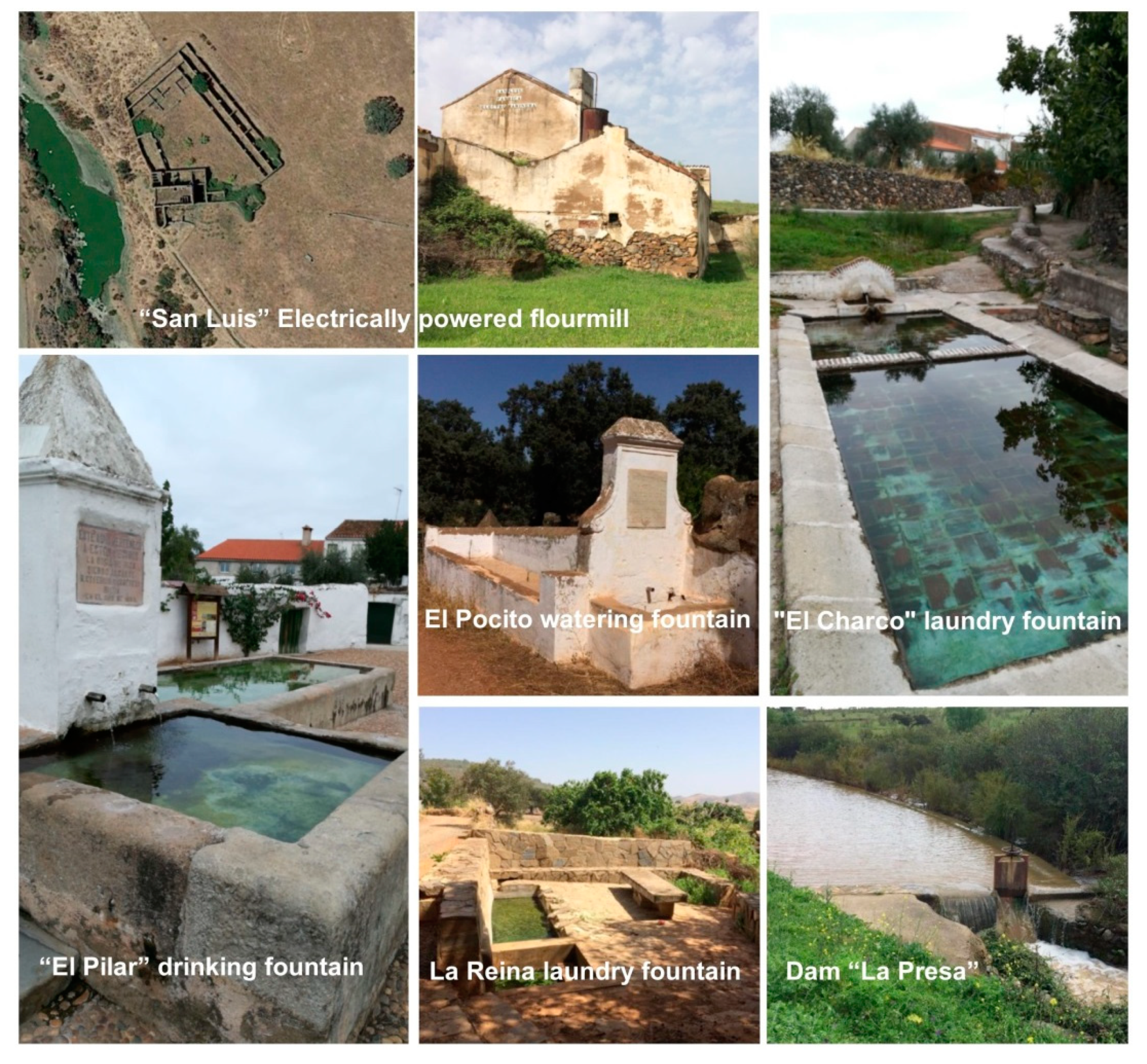
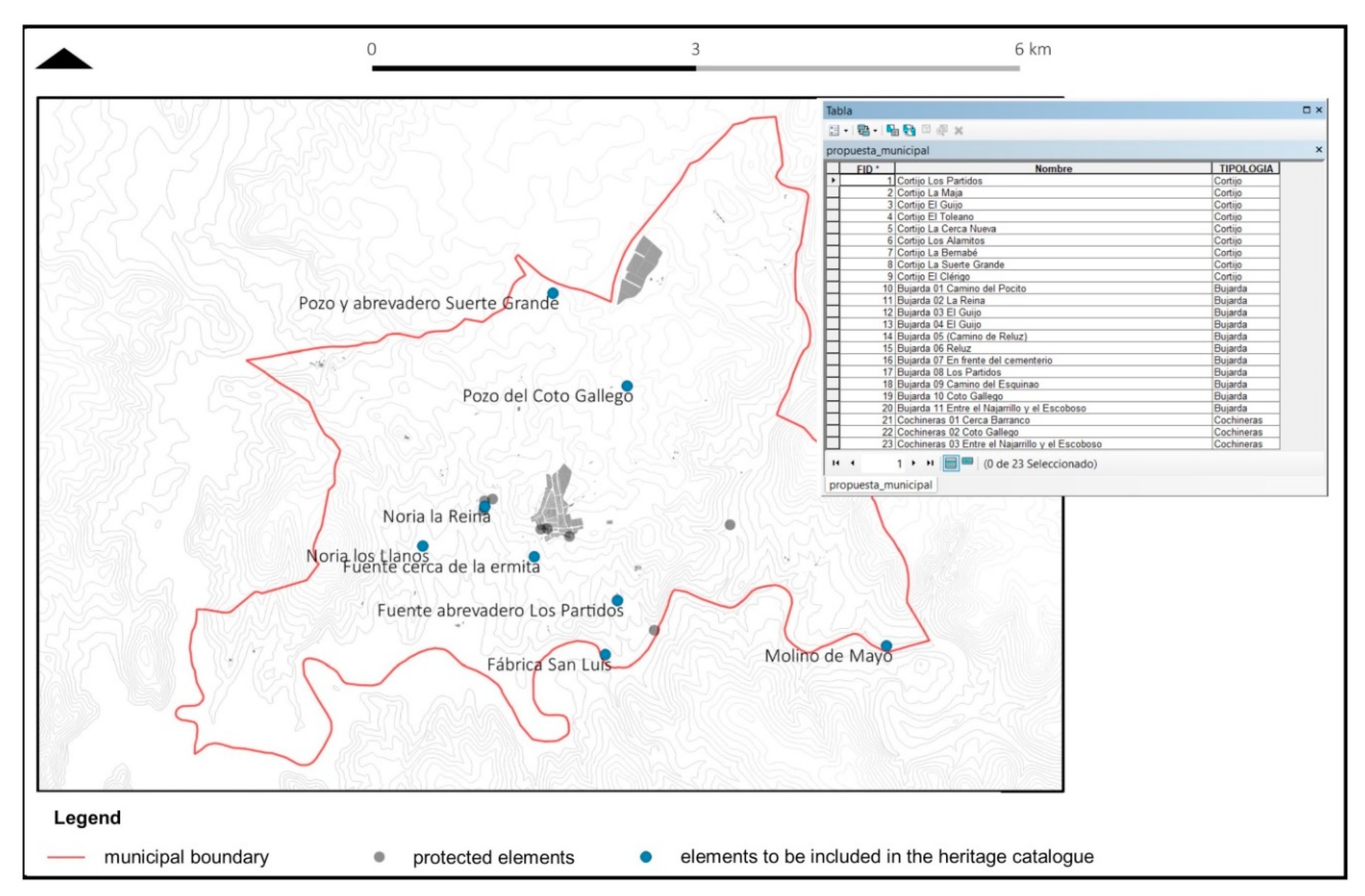
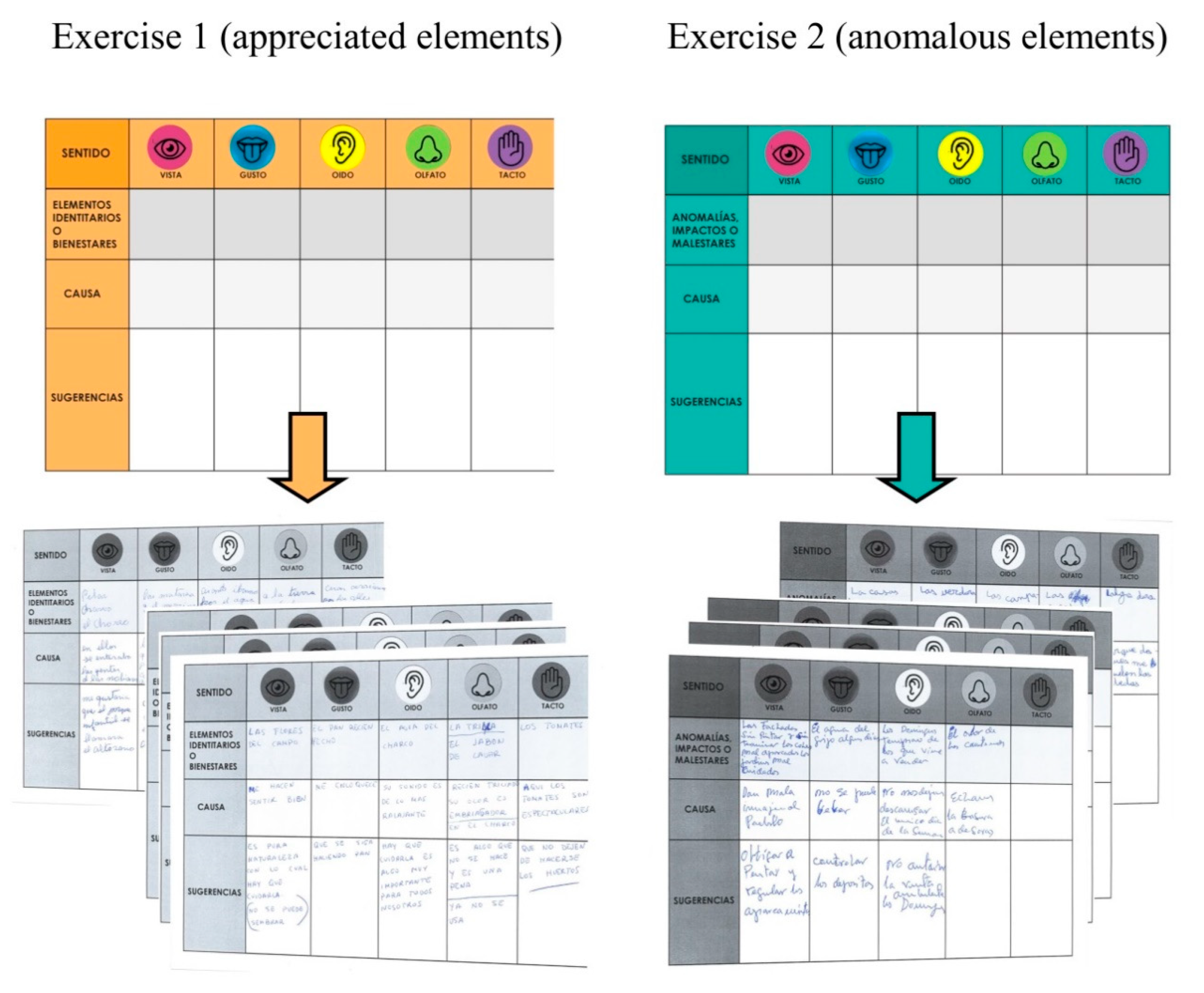

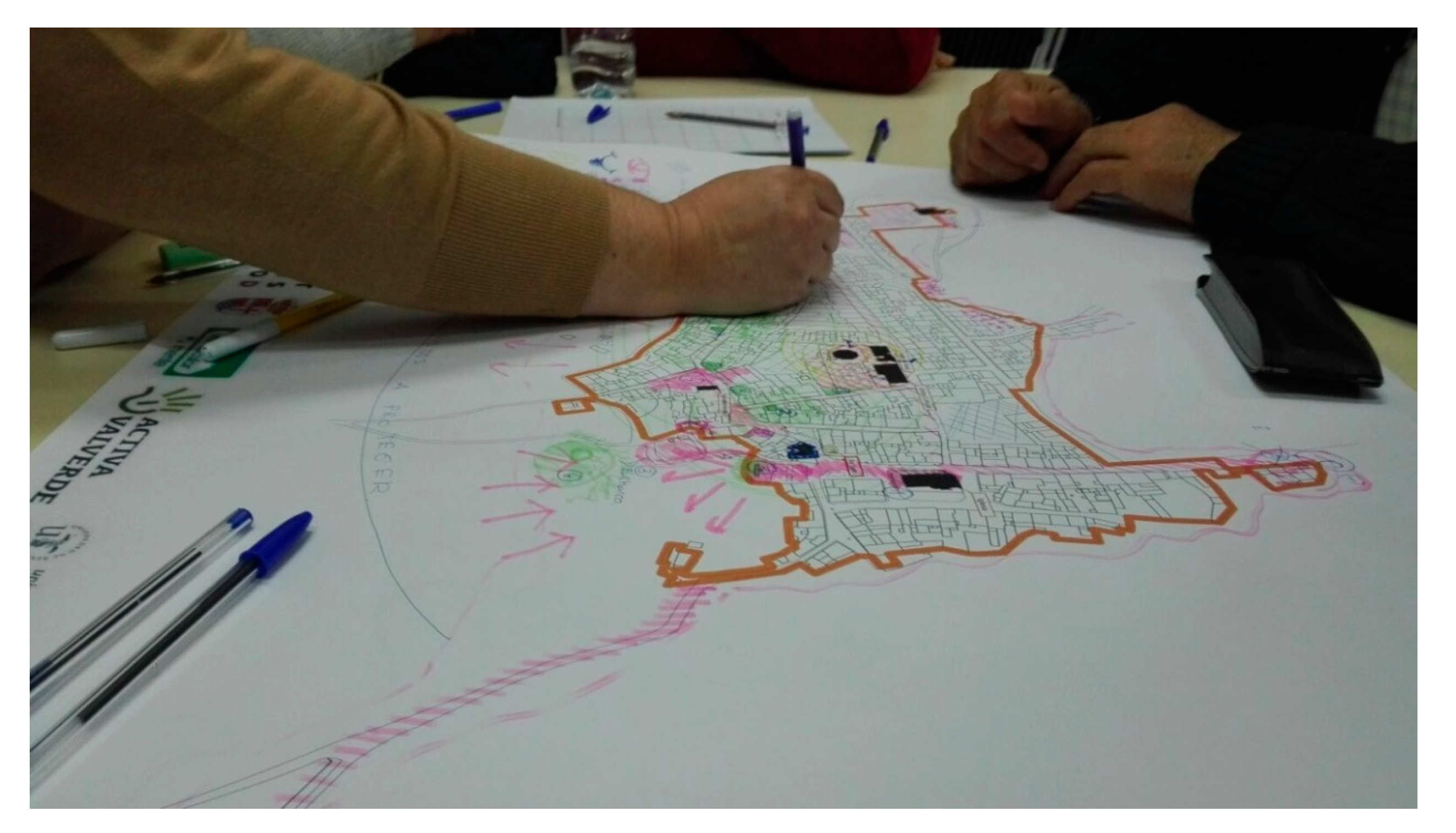
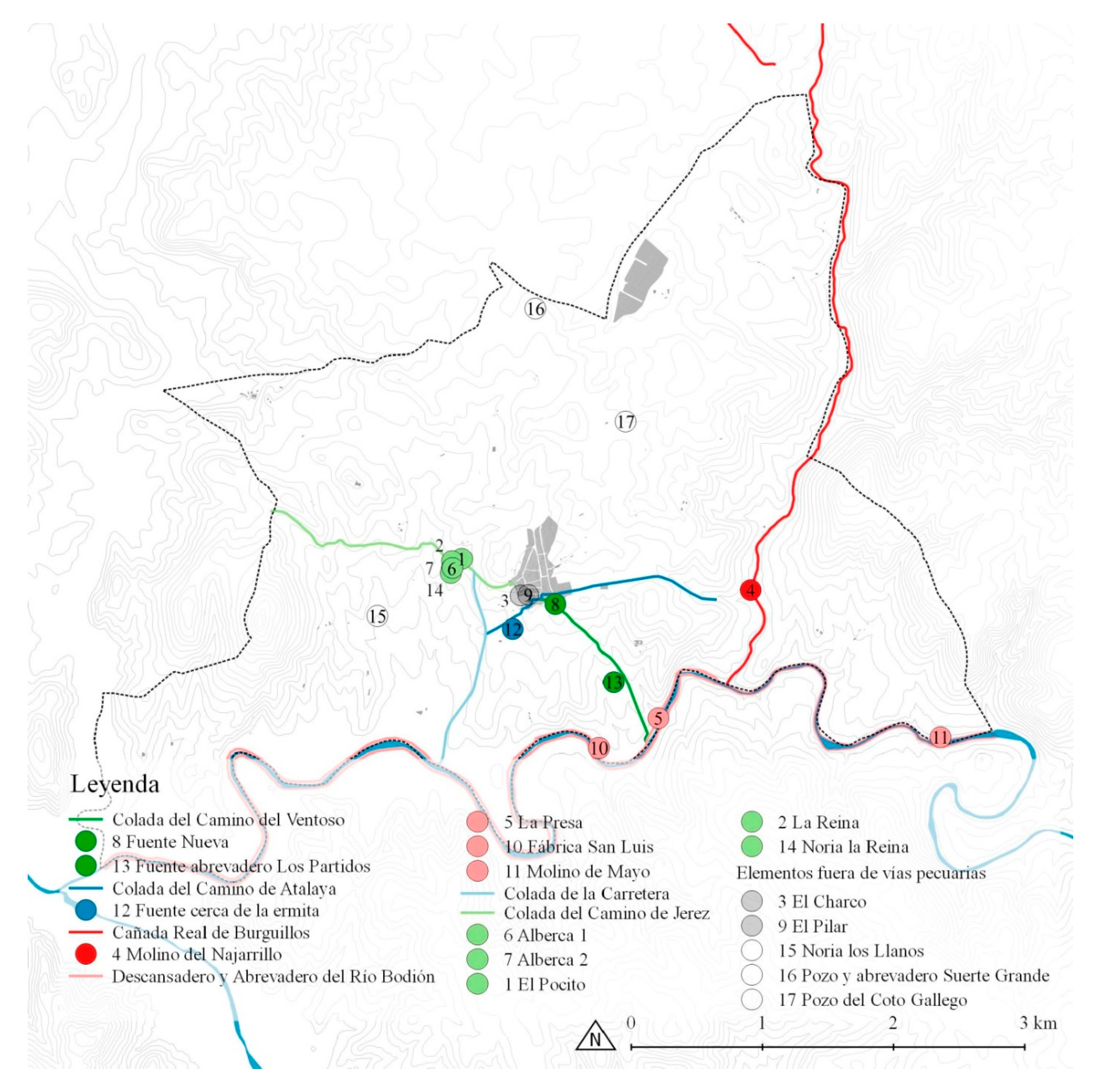
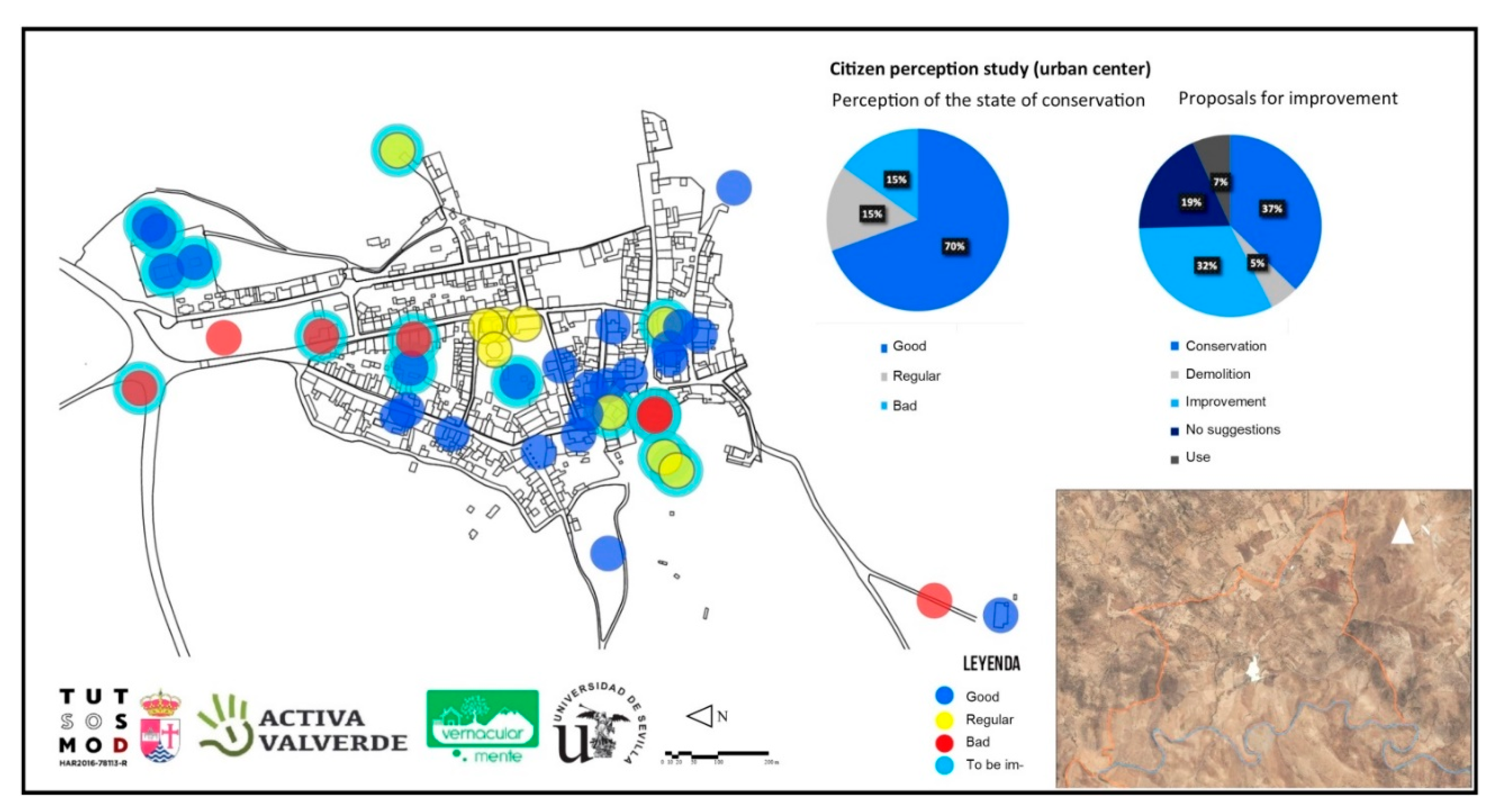
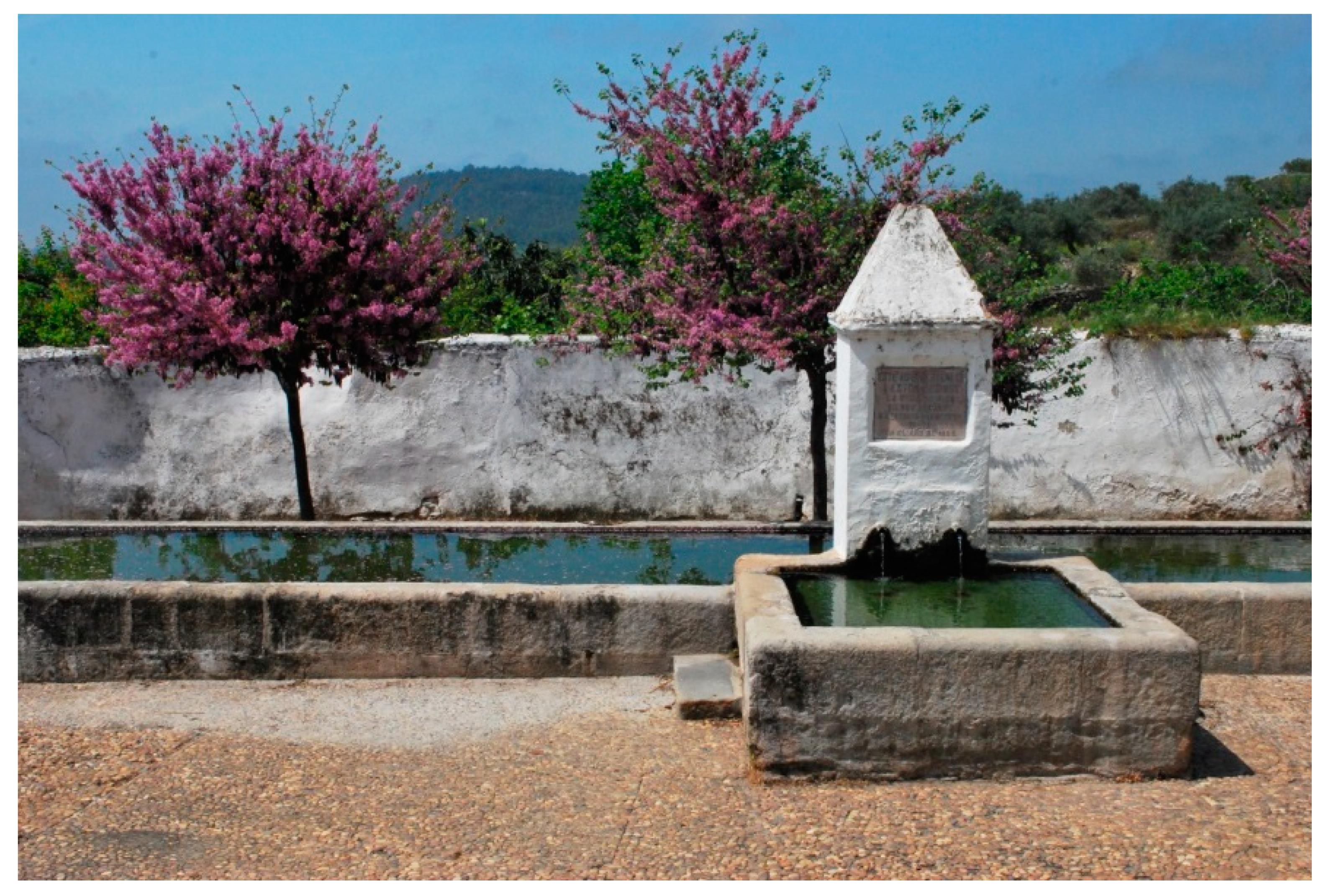
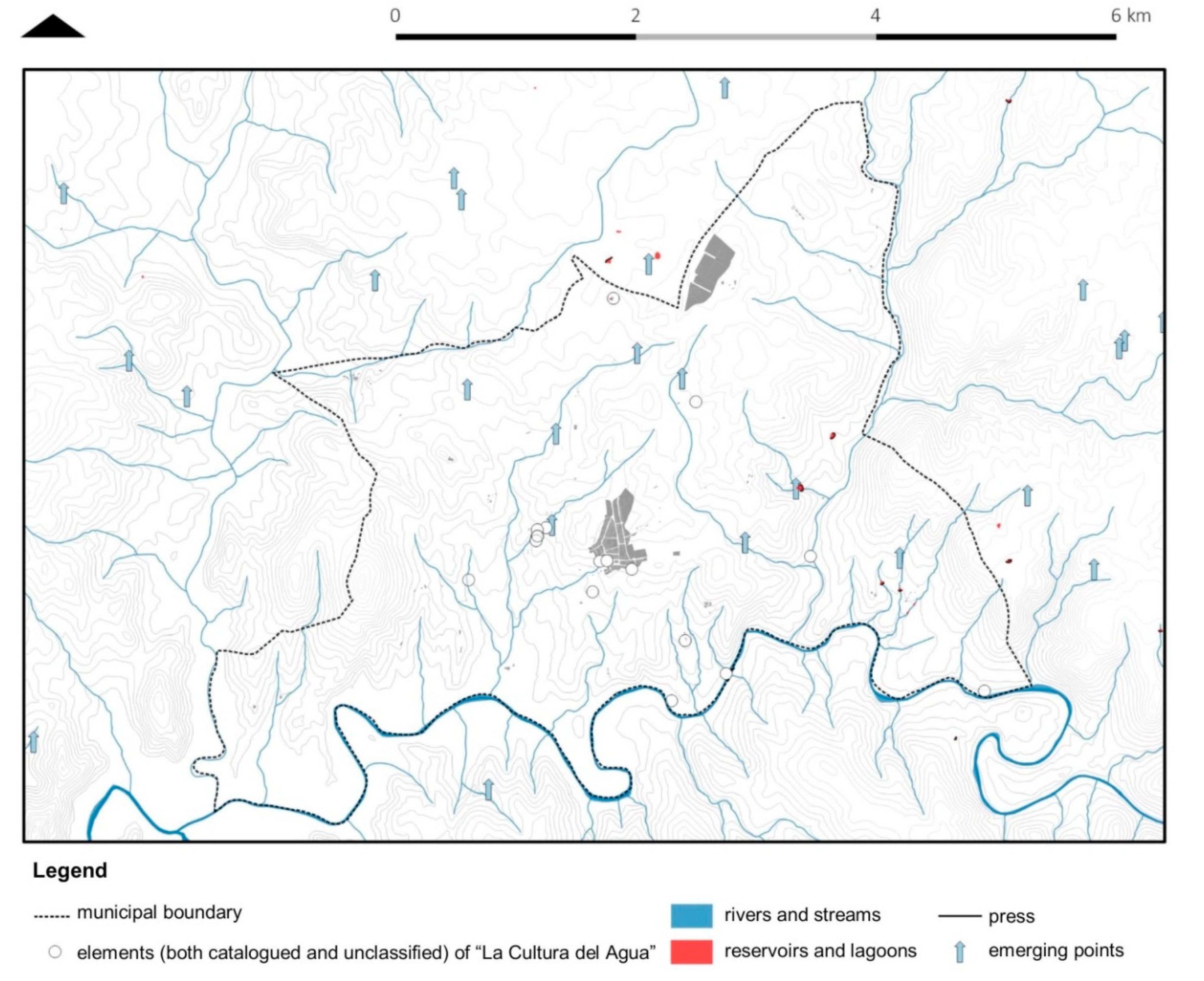
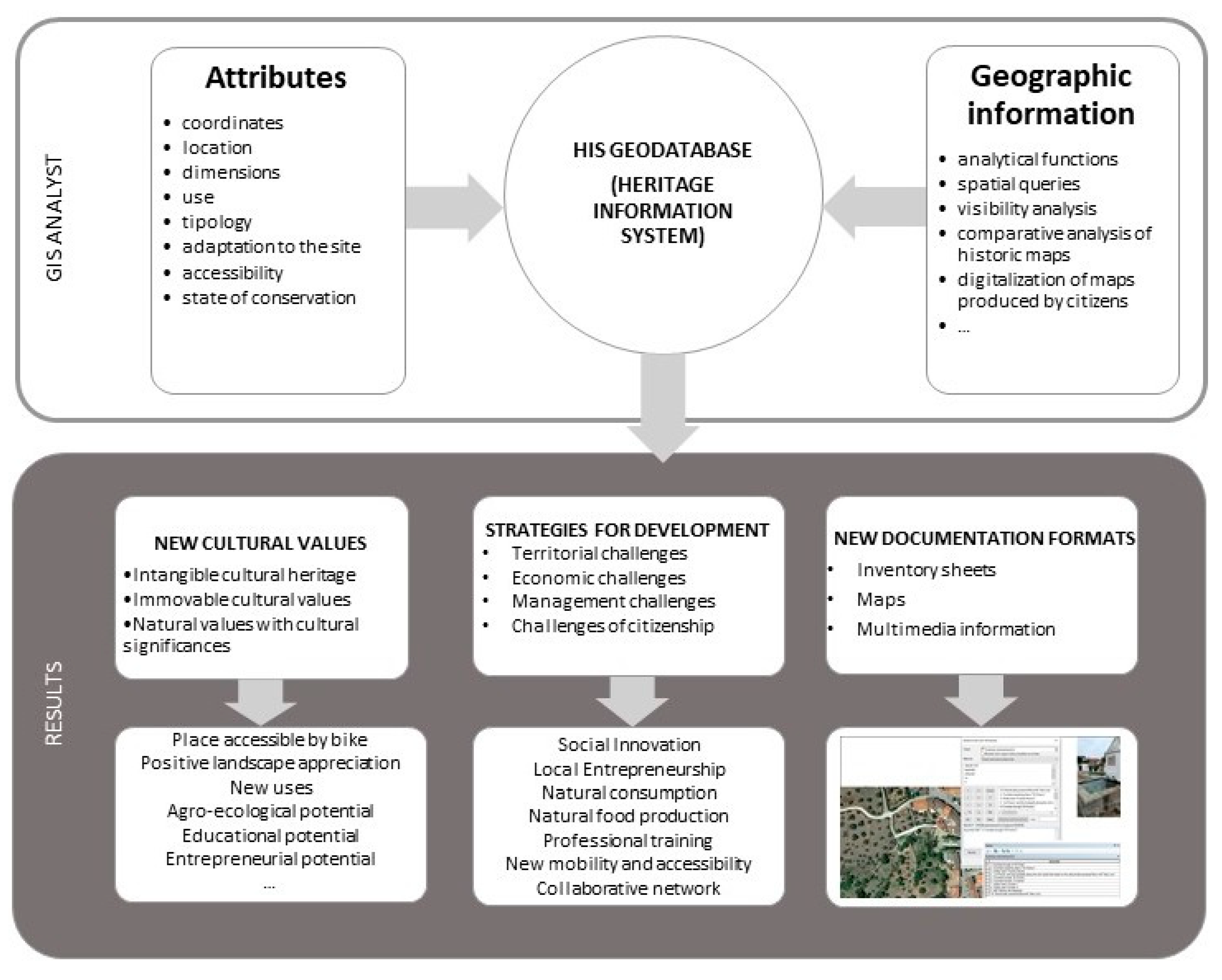
| Historic Urban Landscape Approach. Six Steps. |
|---|
| Mapping of natural, cultural, and human resources |
| Consensus among those involved in what to protect (values and attributes) |
| Assessment of vulnerability to change and development |
| Integration of the information generated in an urban development framework |
| Prioritisation of actions for conservation and development |
| Establishment of local partners and management frameworks |
| Administration | Scientific-Technical Sector | Citizenship |
|---|---|---|
| Protected Natural Spaces [53] (p. 36), [54] Landscape Units [53] (p. 34) Bien de Interés Cultural (BIC) [53] (p. 60) Extremadura Historical Heritage Inventory [53] (p. 61) Inventory of vernacular architecture of Extremadura [53] (p. 62) Municipal Proposal of the Protection Catalogue [53] (p. 62) Archeological Heritage [53] (p. 64) Ethnographic Heritage [53] (p. 70) Declaration of “La Cultura del Agua” [50] | Population setters and municipalities road infrastructure (road network and network of cattle paths) [53] (pp. 37–44), [48,55] Study of Geomorphology, Geology and Hydrology [53] (pp. 9–13), [48,55] Environmental Study [56] Relieve [53] (p. 7,8); contour lines (10 m) [48,55] Flora and Fauna [53] (pp. 14–22) Hydrography (rivers, reservoirs, lakes and dams and emergence points) [53] (p. 29–31), [48,55] Use of land (Corine Land Cover) [53] (p. 32), [48,55] Urban evolution of Valverde Study [53] (pp. 48–49) Typological Study [57] Historic Cartography [58,59] Agro-ecological and livestock potential [47,60,61,62,63] Diffusion of Cultural Heritage [64,65] Study of buildings [57,66,67] “La Cultura del Agua” Studies [49] Intangible heritage study; Historical-critical review of images (History and artistic perception of landscape) [68,69] | Heritage and Sustainability Workshop [70] Citizens’ perception workshop [71] Census of empty houses (elaborated by Asociación Ciudadana Activa Valverde) Census of housing in ruins (prepared by Asociación Ciudadana Activa Valverde) |
| SENSE | SIGHT | TASTE | HEARING | SMELL | TOUCH |
|---|---|---|---|---|---|
| IDENTITY OR WELLBEING ELEMENTS | [hw] Flowers in the country | [hw] Freshly made bread | [hw] Water in the pond | [hw] The threshing Soap for washing | [hw] Tomatoes |
| CAUSE | [hw] They make me feel good | [hw] It drives me wild | [hw] Its sound is really relaxing | [hw] Freshly grounded. Its smell is intoxicating in the pond | [hw] The tomatoes here are second to none |
| SUGGESTIONS | [hw] It is nature in its purest state, so we have to look after it (they can’t be planted) | [hw] That they continue to make bread | [hw] We have to look after it as it is somewhat important for all of us | [hw] It’s no longer done and that is a shame. Not used any more | [hw] That the orchards and vegetable gardens remain in use. |
| SIGHT | No. | TASTE | No. | HEARING | No. | SMELL | No. | TOUCH | No. |
|---|---|---|---|---|---|---|---|---|---|
| Highlands of “El Guijo” country state | 10 | Albéchiga (a local variety of Prunus persica) | 30 | Clock bells | 50 | Trees | 20 | Water | 20 |
| Trees | 10 | Charcoal-grilled (traditional dish) | 10 | Ancient carnivals | 20 | Fire (home candle) | 40 | Animals | 20 |
| Popular architecture | 10 | Cooked frogs (traditional dish) | 40 | Conversation friends | 10 | Mowed grass | 20 | Wall lime | 10 |
| Streets | 30 | Prunus spinosa | 10 | Valverde choir | 10 | Cake | 30 | Climate | 10 |
| Painted facades traditional | 10 | Caldereta (traditional dish) | 10 | “El Charco” laundry fountain | 10 | Flowers of the field | 70 | Education people | 10 |
| Attic | 10 | Camuesa (apple local variety) | 10 | Town fountains | 30 | Gastronomy | 100 | Quercus ilex | 10 |
| “El Charco” laundry fountain | 20 | Pork meat | 20 | “La Presa” (Dam) | 40 | Washing soap (threshing) | 10 | Asparagus | 20 |
| “El Chorro” laundry fountain | 10 | Coriander | 10 | Rain | 20 | Rain | 10 | Family | 20 |
| “El Pilar” drinking fountain | 20 | Piglet | 10 | Nature | 30 | Traditional pig slaughtering | 20 | Flowers of the field | 50 |
| Hermitage of Our Lady of the Valley | 20 | Dessert competition | 10 | Birds | 170 | Orange trees in the street | 10 | Orchards | 10 |
| Flowers of the field | 20 | Cakes | 40 | Bodión river | 10 | Nature | 30 | Traditional games | 30 |
| Town fountains | 10 | Hermitage | 10 | Peace of mind | 10 | Bread | 40 | Pots | 10 |
| Orchards | 10 | Asparagus | 40 | Social life | 30 | Landscape | 10 | Moss | 20 |
| “La Presa” (Dam) | 10 | Gastronomy | 60 | School noise | 10 | Bakery | 40 | Nature | 10 |
| “La Reina” laundry fountain | 20 | Iberian products | 10 | Aromatic plants | 30 | Valverdeños personality | 90 | ||
| Rain | 20 | Serrano ham (jamón) | 10 | Bodión river | 10 | Aromatics plants | 10 | ||
| Light | 10 | Traditional pig slaughtering | 50 | Wet soil | 70 | Orchards products | 20 | ||
| Najarrillo Mill | 10 | Bread | 40 | Sunset | 10 | ||||
| Nature | 30 | Bread and cakes | 30 | Social life | 10 | ||||
| Fog | 10 | Pestorejo (traditional dish) | 10 | ||||||
| Children | 10 | Pringue colorá (traditional dish) | 10 | ||||||
| Landscape | 70 | Salmorejo (traditional dish) | 10 | ||||||
| Birds | 10 | Tomato | 10 | ||||||
| Hermitage walk | 10 | ||||||||
| Sports court | 20 | ||||||||
| “El Pocito” drinking fountain | 20 | ||||||||
| Door church | 10 | ||||||||
| Sunset | 10 | ||||||||
| Bodión river | 30 | ||||||||
| “San Benito” Fest (patron saint) | 10 | ||||||||
| Mountains | 20 | ||||||||
| View from the Jaca | 10 | ||||||||
| Views of the town | 50 | ||||||||
| Views of the Montains from “El Pilar” | 10 |
| SIGHT | No. | TASTE | No. | HEARING | No. | SMELL | No. | TOUCH | No. |
|---|---|---|---|---|---|---|---|---|---|
| Non-integrated architecture | 10 | Tap water | 30 | Sharpener | 20 | Rubbish in containers | 40 | Holes in the pavement | 10 |
| Church railing | 20 | Pork meat | 10 | Animal faeces | 60 | Asphalt | 10 | ||
| Narrow paths | 10 | Missing indigenous species | 10 | Bells | 20 | Foul-smelling herbs | 10 | Bench seat | 10 |
| Empty/deteriorated houses | 120 | New foods | 10 | Too quiet | 20 | Smoke | 10 | Increased summer heat | 20 |
| Chapel enclosure | 10 | Artificial bread | 10 | Less nature | 10 | Smell animals in the street | 10 | Stoned streets | 20 |
| Badly parked cars | 10 | Loss of gastronomy | 60 | Loud music | 40 | Firecrackers | 10 | Facades discordant paintings | 10 |
| Stork’s nest removal | 10 | Blood with tomato (typical dish) | 10 | Firecrakers | 10 | Slurry | 40 | Lack of expression of feelings | 10 |
| Poor transport | 10 | Vegetables | 20 | Sunday noise | 10 | Dirt | 10 | Cold | 10 |
| Rubble | 10 | Noise in the streets | 20 | Tobacco | 10 | The old TV club | 10 | ||
| Foreign species | 10 | Noise parties | 20 | Animal faeces | 10 | ||||
| State of conservation of the church | 50 | Noise vehicle | 80 | Threshold | 10 | ||||
| State of conservation of the dam | 10 | Noise of “San Isidro” Fest | 100 | Loss of securities | 10 | ||||
| State of conservation of “La Reina” laundry fountain | 10 | Itinerant sale | 3 | Loss of people | 10 | ||||
| Facades | 20 | Big stone | 10 | ||||||
| Discordant paintings on the facades | 30 | Personal relationships | 10 | ||||||
| Unpainted facades | 30 | Tree felling | 10 | ||||||
| Animal faeces | 10 | Fabrics | 10 | ||||||
| Fewer people | 10 | ||||||||
| “El Pocito” watering fountain without water | 10 | ||||||||
| Few children | 20 | ||||||||
| Animal overexploitation | 10 | ||||||||
| Solitude | 10 |
| Heritage Material | Natural Heritage | Intangible Heritage | ||
|---|---|---|---|---|
| “La Cultura del Agua” | Vernacular architecture | Other elements of material heritage | ||
| “El Pilar” drinking fountain | Eleven housing in the urban nucleus | Church of Our Lady of Antigua | The Pasturelands | Festivals and traditions (e.g., “San Isidro Labrador” and Fest of Our Lady of the Valley) |
| “El Charco” laundry fountain | “Mayo” water mill | Hermitage of Our Lady of the Valley | The River Channels (Bodión River and its streams (Najarrillo, “Riverita de los Frailes”, etc.) | Gastronomy (e.g., The pig slaughter, the “Garbanzá de San José” and asparagus) |
| Cistern “Fuente Nueva” | Nine Traditional Farmhouses Eleven vernacular constructions for shepherds | Other elements | Flora (Pasturelands, Ribera Forest, Wild plants) | Gastronomic or medicinal uses of plants |
| “La Presa” (Dam) and the pedestrian path | Five livestock Shelter | Archaeological site “El Perrero” | Fauna of the fluvial ecosystem around the Bodión river (e.g., Anaecypris hispánicain danger of extrusion) | Memoirs (e.g., A feeling of relevance, personal and collective feelings and memories) |
| “San Luis” Electrically powered flourmill | Shepherds shelters “Bujarda del Pastor” | Archaeological site “Los Majanos” | Natural Landscapes | Cultural Landscapes |
| “El Pocito” drinking fountain | Set of shelters for shepherds | Megalithic monument “El Viñazo” | Vernacular construction in the urban nucleus: the vaults, the rammed earth and the cladding in brown lime | |
| “La Reina” laundry fountain | Other waterwheels and wells | Megalithic monument “La Borrega” | Vernacular construction in rural settings: dry stone | |
| Pond number 1 | Archaeological site “El Oropel” | |||
| Pond number 2 | Archaeological site “Huerta del Álamo” | |||
| Najarrillo Mill | Water well in “Suerte Grande” | |||
| Livestock pathways | Stone shield on housing facade | |||
| The orchards | Oratory Chapel in housing | |||
Publisher’s Note: MDPI stays neutral with regard to jurisdictional claims in published maps and institutional affiliations. |
© 2020 by the authors. Licensee MDPI, Basel, Switzerland. This article is an open access article distributed under the terms and conditions of the Creative Commons Attribution (CC BY) license (http://creativecommons.org/licenses/by/4.0/).
Share and Cite
Rey-Pérez, J.; Domínguez-Ruiz, V. Multidisciplinarity, Citizen Participation and Geographic Information System, Cross-Cutting Strategies for Sustainable Development in Rural Heritage. The Case Study of Valverde de Burguillos (Spain). Sustainability 2020, 12, 9628. https://doi.org/10.3390/su12229628
Rey-Pérez J, Domínguez-Ruiz V. Multidisciplinarity, Citizen Participation and Geographic Information System, Cross-Cutting Strategies for Sustainable Development in Rural Heritage. The Case Study of Valverde de Burguillos (Spain). Sustainability. 2020; 12(22):9628. https://doi.org/10.3390/su12229628
Chicago/Turabian StyleRey-Pérez, Julia, and Victoria Domínguez-Ruiz. 2020. "Multidisciplinarity, Citizen Participation and Geographic Information System, Cross-Cutting Strategies for Sustainable Development in Rural Heritage. The Case Study of Valverde de Burguillos (Spain)" Sustainability 12, no. 22: 9628. https://doi.org/10.3390/su12229628
APA StyleRey-Pérez, J., & Domínguez-Ruiz, V. (2020). Multidisciplinarity, Citizen Participation and Geographic Information System, Cross-Cutting Strategies for Sustainable Development in Rural Heritage. The Case Study of Valverde de Burguillos (Spain). Sustainability, 12(22), 9628. https://doi.org/10.3390/su12229628





